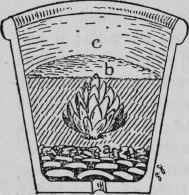February - First And Second Weeks. Flowers. Part 3
Description
This section is from the book "The Garden Week By Week Throughout The Year", by Walter P. Wright. Also available from Amazon: The Garden Week by Week Throughout the Year.
February - First And Second Weeks. Flowers. Part 3
Stocks For Pots
Do amateurs in general know the East Lothian Stock, I wonder? It is a form of the Intermediate, a dwarf Stock of neat habit, the special value of which lies in the fact that it will bloom under glass in winter and spring, if raised from seed the previous summer. It is because they generally bloom the year following the sowing that the Intermediate Stocks are often described as biennials, but if they are sown in February or March they will flower the same year, and therefore they are annuals. Every owner of a greenhouse who loves bright and fragrant Stocks should make the acquaintance of the East Lothian section. He can buy in separate colours, such as pink, scarlet, crimson, and white, or in mixture. By sowing this month in a warm house, one gets plants in bloom by mid-summer. The same treatment as for other seedlings raised in winter will suffice, but particular attention must be paid to watering and ventilating, as young Stocks are of all plants the most ready to "damp off".
Imported Japanese Lilies
The golden-rayed Lilium Auratum is rather dear in autumn, because the only bulbs available then are English. The Japanese can grow the Lilies much cheaper than we, but they cannot get their bulbs to us until winter. Imported bulbs are generally plentiful and cheap in February. They are procurable from bulb merchants, who advertise in the horticultural papers, and also at auction sales. The defect of these bulbs is that they are sometimes loose and soft, but that is not fatal to flowering unless they are downright spongy. A batch of importations often yield different types of flower. If the grower gets a good pure white he has a treasure. The large white, with crimson spots, called Platyphyllum, is very fine, and so is the red-barred Rubro-Vittatum. Wittei is pure white. The amateur may wish to grow the Lilies for his conservatory, and if so he had better put them low down in 7-inch or 8-inch pots, and barely cover them with soil until they are growing freely and pushing stem roots, when he can fill up the pots nearly to the top. It is a very good plan with these, as with nearly all bulbs, to keep them under cocoa-nut fibre for six weeks after potting, in order to give the roots a chance of spreading before the stem growth makes great demands upon them. A soil made up of three parts loam, one part decayed manure, one part peat, and a liberal mixture of coarse sand suits the Japanese Lily. One finds that such an addition to garden soil, if the latter is stiff, helps the plants immensely when they are grown out of doors; at the least some sand should be put in the hole.

Fig. 26. - Potting Liliums.
a. Crocks for drainage.
b. Bulb potted.
c. Space left for future topdressing.
The Fern-Like Grevillea
One is often asked "the name of this fern" by amateurs who show a tallish, graceful plant, with much cut (laciniated) leaves, which they are growing in the greenhouse or conservatory. It is not a fern, but an Australian evergreen shrub named Grevillea Robusta, after one Greville. It bears orange-coloured flowers in early summer, but nobody grows it for the sake of the blossoms. Gardeners like to arrange it with flowering plants in conservatories. It is very handsome, and gives little trouble, requiring no care beyond watering and ventilating. Most seedsmen supply the Grevillea, and early February is a good time to sow. It likes a warm, moist house from the first. Dryness, either at the root or in the atmosphere, is distasteful to it.
Continue to:


